| |
| |
| Craig Blackstone, M.D., Ph.D., Investigator |
 |
Dr. Blackstone received B.S. and M.S. degrees in 1987 from the University of Chicago and M.D. and Ph.D. degrees in 1994 from Johns Hopkins University. His graduate studies, in the laboratory of Richard Huganir, were on the structure and regulation of glutamate receptors, for which he received the David Israel Macht Award. After a neurology residency at the Harvard-Longwood Neurology Program, Dr. Blackstone completed a fellowship in clinical movement disorders at the Massachusetts General Hospital. During this time he also conducted postdoctoral research with Morgan Sheng at Harvard Medical School, investigating the functions of proteins implicated in hereditary dystonias. Dr. Blackstone joined the NINDS as an investigator in 2001. His laboratory investigates the cellular and molecular mechanisms underlying hereditary movement disorders.
|

|
Staff:

- Dr. Chuang-Rung Chang, Ph.D., Postdoctoral Fellow, (301) 451-9684 changchu@ninds.nih.gov
- Dr. Michael C Hanna, Ph.D., Special Volunteer, (301) 451-9686 hannam@ninds.nih.gov
- Dr. Seong-hee Park, Ph.D., Postdoctoral Fellow parkseo@ninds.nih.gov
- Dr. Benoit Renvoise, Ph.D., Postdoctoral Fellow, (301) 451-9682 renvoisebr@ninds.nih.gov
- Dr. Neggy Rismanchi, Ph.D., Special Volunteer, (301) 496-0284 rismancn@ninds.nih.gov
- Cynthia Soderblom, B.S., Predoctoral Fellow, (301) 451-9683 soderblc@ninds.nih.gov
- Julia Stadler, B.A., Research Assistant, (301) 451-9685 stadlerj@ninds.nih.gov
- Dr. Peng-Peng Zhu, M.D., Staff Scientist, (301) 451-9687 zhup@ninds.nih.gov
Research Interests:
Research in the Cellular Neurology Unit emphasizes two major disease-related aims. The first focuses on understanding the cellular pathogenesis of a group of disorders known as the hereditary spastic paraplegias (HSPs), whose cardinal feature is a length-dependent axonopathy of corticospinal motor neurons. A particular advantage in piecing together the molecular and cellular pathogenesis underlying the HSPs is that well over 30 genetic loci (SPG1-33) have been mapped, with 16 gene products already identified that segregate into a smaller number of functional groups. Many of these proteins are suspected to be involved in protein and membrane trafficking, and we are currently studying HSP disease proteins involved in both secretory and endocytic pathways.
A second major research aim in our laboratory is directed towards understanding the regulation of mitochondrial fission and fusion within cells. Three of the major proteins involved in these complementary processes are large, dynamin-related GTPases mutated in autosomal dominant neurological disorders, including Charcot-Marie-Tooth 2A (mutations in Mfn2 protein), optic atrophy type 1 (OPA1 protein), and a rare syndrome characterized by optic atrophy, lactic acidemia, and abnormal brain development (Drp1 protein). We are emphasizing investigations of the Drp1 GTPase that is involved in mitochondrial division. In particular, we are examining regulation of this protein through post-translational modifications as well as interactions with other proteins, several of which our laboratory identified. Within both major themes, we are conducting studies ranging from clinical characterizations of humans with disease mutations to mouse models, cellular and molecular studies, and structural biology investigations.
Our long-term goals are to use insights from inherited neurological diseases to highlight clinically-relevant cellular pathways, emphasizing both normal functions of disease proteins in these pathways and their disruption in disease.
|
Selected Recent Publications:
Rismanchi R, Puertollano R, Blackstone C (InPress) STAM Adaptor Proteins Interact with COPII Complexes and Function in ER-to-Golgi Trafficking, Traffic.
Full Text/Abstract
Rismanchi N, Soderblom C, Stadler J, Zhu P-P, Blackstone C (2008) Atlastin GTPases are required for Golgi apparatus and ER morphogenesis, Hum Molec Genet 17, 1591-1604.
Full Text/Abstract
Bakowska JC, Wang H, Xin B, Sumner CJ, Blackstone C (2008) Loss of spartin protein in Troyer syndrome: a loss-of-function disease mechanism?, Arch Neurol 65, 520-524.
Full Text/Abstract
Yang D, Rismanchi N, Renvoise B, Lippincott-Schwartz J, Blackstone C, Hurley JH (2008) Structural basis for midbody targeting of spastin by the ESCRT-III protein CHMP1B, Nat Struct Mol Biol 15, 1278-1286.
Full Text/Abstract
Bakowska J, Jupille H, Fatheddin P, Puertollano R, Blackstone C (2007) Troyer syndrome protein spartin is mono-ubiquitinated and functions in EGF receptor trafficking, Mol Biol Cell 18, 1683-1692.
Full Text/Abstract
Chang C-R, Blackstone C (2007) Cyclic-AMP-dependent phosphorylation of Drp1 regulates its GTPase activity and mitochondrial morphology, J Biol Chem 282, 21583-21587.
Full Text/Abstract
Zhu P-P, Soderblom C, Tao-Cheng J-H, Stadler J, Blackstone C (2006) SPG3A protein atlastin-1 is enriched in growth cones and promotes axon elongation during neuronal development, Hum Mol Genet 15, 1343-1353.
Full Text/Abstract
All Selected Publications
Contact Information:
Dr. Craig Blackstone
Cellular Neurology Unit, NINDS
Porter Neuroscience Research Center
Building 35, Room 2C-913
35 Convent Drive, MSC 3704
Bethesda, MD 20892-3704
Telephone: (301) 451-9680 (office),
(301) 480-4888 (fax)
Email: blackstc@ninds.nih.gov
|
|















